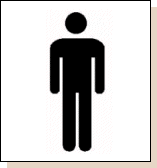|
The above song, a one-hit wonder from 1971, is a particularly historically and culturally situated lyrical consideration of signs — in the denotative sense, surely (actual posts and placards containing written messages), but also in various connotative senses.
Semiotics, as outlined in the Danesi reading, can be a lot to get your head around. If you'd like more in-depth background on signs, codes, texts, and more, look to this excellent primer, "Semiotics for Beginners," particularly parts 1, 2, 7, and 9. Participation! Consider this image below, indicating the appropriate gender of restroom facilities. Does it look more like a man than a woman? Why? What is indexed? What is symbolized?
5 Comments
Kaithleen Apostol
1/24/2016 05:48:22 pm
We have grown up to believe that it looks more like a man. When we see restroom facilities, we are able to differentiate which sex is which bathroom. Due to gender formation, we automatically believe that the woman's sign is feminine because it's wearing a dress, whereas the men's sign is opposite.
Reply
Clayre
1/27/2016 12:33:49 am
Participation :
Reply
Thomas Conner
2/19/2016 11:27:45 am
Consider your response here. You say the stick figure is male because it exhibits no female attributes. I would suggest it doesn't show any male attributes, either. The assumption that the figure is male because it does not show any further identifying features is precisely what we mean in our discussion of the unmarked/privileged side of a social binary!
Reply
Xinyi Zhan
2/18/2016 05:50:58 pm
This sign resembles a man more than a woman. Maybe it's based on the subconscious idea we have formed since childhood that this sign symbolizes men room and the one with dress on symbolizes women. Also, this sign is somewhat angular without tenderness of female. That's probably why I think it resebles a man more than a woman.
Reply
Jason Ma
2/27/2016 01:22:25 am
To me, it's always been apparent that the symbol representing males has always had broader shoulders, and a straight/tall figure even if it isn't actually taller than the symbol used to represent females.
Reply
Leave a Reply. |
COMM 10
|

 RSS Feed
RSS Feed